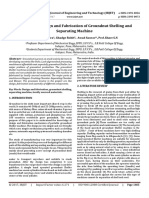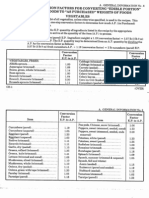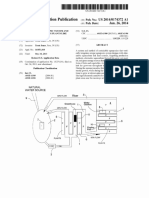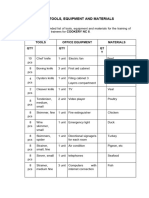109am - 5.EPRA JOURNALS-5089
109am - 5.EPRA JOURNALS-5089
Uploaded by
ashraf.imraishCopyright:
Available Formats
109am - 5.EPRA JOURNALS-5089
109am - 5.EPRA JOURNALS-5089
Uploaded by
ashraf.imraishOriginal Title
Copyright
Available Formats
Share this document
Did you find this document useful?
Is this content inappropriate?
Copyright:
Available Formats
109am - 5.EPRA JOURNALS-5089
109am - 5.EPRA JOURNALS-5089
Uploaded by
ashraf.imraishCopyright:
Available Formats
SJIF Impact Factor: 7.001| ISI I.F.Value:1.241| Journal DOI: 10.
36713/epra2016 ISSN: 2455-7838(Online)
EPRA International Journal of Research and Development (IJRD)
Volume: 5 | Issue: 9 | September 2020 - Peer Reviewed Journal
DESIGN, CONSTRUCTION AND EVALUATION OF
GROUNDNUT SHELLING MACHINE PEDAL OPERATED
Engr Aminu Baba Usman
Adamawa State Polytechnic,College of Engineering Technology, Department of Mechanical
Engineering
Ezekiel Usman Jabba
Adamawa State Polytechnic,College of Engineering Technology, Department of Mechanical
Engineering
ABSTRACT
Shelling is the removal of grains from their stalk or pod by stripping, impact action, rubbing or any combination of
these methods. The most popular method of shelling which is still widely used in the northern part of Nigeria is the
method of crushing or pressing the pods between the thumb and the finger to break off the pods and release the seed.
This method has low efficiency, it is time consuming, and has high demand of energy. In addition, the output per-man
hour is as low as 1-2.5kg of groundnut. There are different methods of shelling and different machines have been
fabricated and used to shell wide variety of crops under different condition. The peasant farmer cannot afford these
machines because they are too costly and complex in operation and maintenance. Also the operator had to be trained
and spare parts imported. These factors increase the overall cost of production which does not make any economic sense
to the farmer which necessitated the need for designing, construction and evaluation of a groundnut shelling machine
pedal operated. Materials for the design include shaft, chain, sprocket, bearing, Sheller bit and columns. The product
to be shelled is fed through the hopper which falls into the shelling chamber which is powered by pedaling by means of
chain and sprocket connections. The concave forms the base of the crushing chamber which allow the ground nut to
move in between the Sheller bit and the concave where they will be shelled falling through the perforation on the
groundnut concave which has higher production output and easy to maintain.
KEYWORDS:- Groundnut, shelling machine pedal operated
INTRODUCTION the global production of this crop. The production of
Groundnut is the sixth most important oilseed groundnut is concentrated in Asia and Africa (56% and
crop in the world. It contains 48-50% oil and 26-28% 40% of the global area and 68% and 25% of the global
protein, and is a rich source of dietary fiber, minerals production, (Acharya, 1990). Over 60% of global
and vitamins. It grows best on soils that are well groundnut production is crushed for extraction of oil
drained, loosely textured and well supplied with for edible and industrial uses while 40% is consumed in
calcium, potassium and phosphorous. Over 100 food uses and other "such as seed for sowing in the
countries worldwide grow groundnut. Developing next season crop" (Birthal, Nigam, Narayanan and
countries constitute 97% of the global area and 94% of Kareen, 2011). Groundnut haulms constitute nutrition
2020 EPRA IJRD | Journal DOI: https://doi.org/10.36713/epra2016 | www.eprajournals.com |22 |
SJIF Impact Factor: 7.001| ISI I.F.Value:1.241| Journal DOI: 10.36713/epra2016 ISSN: 2455-7838(Online)
EPRA International Journal of Research and Development (IJRD)
Volume: 5 | Issue: 9 | September 2020 - Peer Reviewed Journal
fodder for livestock, they contain protein (8-15%) major short coming of this machine is that it is labor
lipids (1-3%) mineral (9-17%) and carbohydrate (38- intensive and consumes lots of time. Output is about
40%) at level higher than cereal fodder. The 60-80kg/hour. This particular design overcomes all
digestibility of nutrients in the groundnut haulm is those short comings and also has an improved
around 53% and that of crude protein is 88% when feed efficiency. It comprises the hopper, crushing chamber,
to cattle. Haulms release energy up to 2337 Cal Kg-1 of separation chamber and the blower unit. It is also
dry matter. Being a legume crop, groundnut help in powered by pedaling, which saves time and with a well
improving soil health and fertility by leaving behind improved shelling capacity. The machine is also in
Nitrogen (N2) and organic matter in the soil. light weight and easy to operate and maintain, the spare
(Pasupaleti, Nigam, and Rajeev, 2013) parts are also available locally Ugwuoke et-al (2014).
Shelling is the removal of grains from their In the beginning the nuts were separate from shell by
stalk, pod or cub, either by stripping, impact action and workers. The hand method by opening the pod up and
rubbing or any combination of these methods. groundnut is removed from it, the method is very slow
Kulbhushan, Nitin, and Abhijit, (2017) in their research and it was also boring and production rate is in small
paper it is reported that based on the shelling action quantity, and also the traditional method of separating
they can be divided into two categories. Hand operated nuts from groundnuts by putting the peanut in a cloth
and pedal operated, hand operated groundnut bag and rolling over it with a rolling pin, the technique
decorticator 50-75Kg per hour capacity was evaluated, did good job of cracking the shell (deleting the pain full
whereas a pedal operated groundnut decorticator was finger problem).This is not a reliable method for shell a
found to have capacity of 75Kg/hour. groundnut due to the crack the groundnut and nut
The most popular method of shelling which is mixed with shell basic on this the traditional method is
still widely used in the northern part of Nigeria is the not a sufficient method for separating the groundnut.
method of crushing or pressing the pods between the The researchers identify some major problem and to
thumb and the finger to break off the pods and release overcome this problem, in views of this research it
the seed. This method has low efficiency, it is time develops and evaluate groundnut shelling machine
consuming, and has high demand of energy. In pedal operated. The research objectives include to:-
addition, the output per-man hour is as low as 1-2.5kg To design and construct a simple groundnut
of groundnut. There are different methods of shelling shelling machine pedal operated
and different machines have been fabricated and used To design adjustable shelling bit
to shell wide variety of crops under different conditions To reduce the fatigue involve during operation
(Ebunilo, Orhorhoro, Oviorunraye, and Owunna, of the machine
2016). The peasant farmer cannot afford these A machine which easy to operate and
machines because they are too costly and complex in maintain.
operation and maintenance. Also the operator had to be Sheller’s are generally machine used for the
trained and spare parts imported. These factors increase removing of shells (husk) of groundnut, bean, and
the overall cost of production which does not make any cowpea e.t.c by opening their bivalves. The groundnut
economic sense to the farmer. Hand operated shelling Sheller is a machine designed specifically for shelling
machine which is of concave or semi-rotary design is groundnut from its shells.
widely used locally. It had no expelling unit; hence Ugwuoke et-al (2014). Their work focused on
separation is achieved by winnowing. A simple hand the design and fabrication of a groundnut shelling and
operated groundnut Sheller has a semi-cylindrical separating machine electrically powered by a 1hp
screen closed on both sides. A shaft carrying a lever at motor. The machine has a capacity of shelling 400kg of
one end is fixed across the centre of the semi-cylinder. groundnut per hour with shelling and separating
On the lever is a pair of plate with shoes or beater bars, efficiencies of 95.75 percent respectively. The machine
having blunts on their undersides. For successful is cheaper to maintain. It is also light weight and
operation of the machine, the operator stands by the comprises of the hopper, crushing champers, separation
side, then holding the operating lever (handle) and champers and the blower unit, but required a trained
swinging it by pushing to and fro to provide shelling labour.
action on the shoes assembly. The semi-rotary, action
of the shoes shells the pods against the screen. The
2020 EPRA IJRD | Journal DOI: https://doi.org/10.36713/epra2016 | www.eprajournals.com |23 |
SJIF Impact Factor: 7.001| ISI I.F.Value:1.241| Journal DOI: 10.36713/epra2016 ISSN: 2455-7838(Online)
EPRA International Journal of Research and Development (IJRD)
Volume: 5 | Issue: 9 | September 2020 - Peer Reviewed Journal
Handa et-al (2014) Design and fabrication of
a groundnut Sheller machine, the performance of the Unshelled groundnut, Ung = X 100
machine was evaluated in terms of through shelling
efficiency, material efficiently and mechanical change. Where Ung = Unshelled groundnut, %
Anantachar et-al (1997) Development and performance Wng = Weight of unshelled groundnut,
evaluation of pedal operated decorticator. The major Kg
component of the decorticator is Sheller shaft, sieve, Wg = Weight of total feed, Kg
decortications champers, hopper, and supporting frame
of a pedal operated device. Separation efficiency, Es = 1- X 100
Mathew John (1992) In Nigeria a student of federal
Where Wu = weight of unshelled groundnut,
university of technology in Adamawa state fabricates
Kg
the manually operated fabricated in 1992.Sanusi
Wt = total weight of groundnut feed
Abubakar (2012) made two improvements on the
in the machine, Kg.
machine, to reduce the fatigue and difficulty in using
Design Parameters
the manually conventional type by employing the use
The researchers put into consideration parts of
of electric motor or diesel engine as the power source.
the groundnut Sheller machine which includes the
following: -
METHODOLOGY Chain
Materials for the design and construction of To eliminate the use of large diameter gear on
the modified groundnut Shelling machine were the this machine chain is then used. They can either be
shaft, the chain sprocket, and bearing. Sheller bit, the block chain, roller chain or inverter troth, sometimes
columns. The material were locally purchased and they celled silent chain and each is suitable for different
are selected based on the power required for the types of operations. The researchers make used of the
groundnut Shelling machine. In order to achieve high roller types of chain because is rugged and durable and
efficiency reliability and cheap method of producing if properly selected installed and lubricated it give a
the shelling machine, the researcher take into very good service.
consideration the principles of operation of the Sprocket
machine, convenience of operation rate of shelling to This involve the use of bicycle sprocket to
meet commercial needs ease of manufacturer of the provide the power, it was a simple task to attach the
machine among others. In this research the vertical is bicycle sprocket to a platform where the operator sits
replaced by a pedaling system which was peddled by on the platform and pedal, which in turn powered the
an operator as it obtains in a bicycle. The Sheller unit is sprocket B. And it is cheaply found in local market and
bolted down and can be dismantled for service by for this reason it is selected for the machine. The choice
loosening the bolts which holds down bearing house. of sprocket and the chain is based on power take off.
The following parameter were calculated Sheller Bit
using the standard formula as given below by Nagesh, It is made up of wood and steel fixed to a
Mohan, Dhanush, and kiran, (2018). rotating shaft, as it rotates. It creates a pressure there by
shelling the groundnut seeds on the groundnut concave
Shelling Capacity, Sc =
where both the shells and the groundnut seeds comes
Where Sc = shelling capacity, Kg/h out from it.
Ws = Weight of shelled groundnut, Kg Bearing
T = Operating time, Minute. The shaft is supported by ball bearing which are
located inside the bearing housing and bolted to the
Breakage Percentage, Br = X 100 mainframe. The ball bearing has the following
advantage.
Where Br = breakage percentage Low coefficient of fraction
Wb = Weight of broken groundnut, Kg Have less axial space.
Ws = Weight of shelled groundnut, Kg Lubrication is simple
Wear is negligible if lubricant is correct
2020 EPRA IJRD | Journal DOI: https://doi.org/10.36713/epra2016 | www.eprajournals.com |24 |
SJIF Impact Factor: 7.001| ISI I.F.Value:1.241| Journal DOI: 10.36713/epra2016 ISSN: 2455-7838(Online)
EPRA International Journal of Research and Development (IJRD)
Volume: 5 | Issue: 9 | September 2020 - Peer Reviewed Journal
Columns Similarly, V2 = Volume of the shelling drum is given
They are vertical supports that carry machine or as
structures. They can be made up of wood, metal, or V2 = πr22L2
concrete. But in this research, the researchers make use Where:- d1= diameter of the drum
of metal. d2 = diameter of the shelling drum
Design Analyses r1 = radius of the drum
The various dimensions of the machine have to be r2 = radius of the shelling drum
determined for the successful operation of the machine. L1 = length of the drum
The important parameter includes: - L2 = length of the shelling drum
Shafts The Volume of the Shelling Unit is given by
For solid shaft as in the groundnut shelling machine the V0 = V 1 - V2
required shaft size is given by Assembly of the Machine
Ss =16Mt/πd3 --------------------------------- (1) In this research the hopper was be welded to
the shelling unit casing, and the discharge unit were
Where: - Ss =Shear stress 4000N/m2 for shaft with key also being welded to the shelling unit at the bottom side
ways. which covers the groundnut concave as intended to.
Mt =Tensional moment. The shelling unit which carries the hopper and the
D = shaft diameter discharge unit was mounted into the frame and were
but the tensional moment acting on shaft can be bolted to the frame. And the transmission shaft passes
determined from Mt =9550Kw/rpm and the power through the horizontally inserted or place inside the
produced by a normal human is 50w. Also the average shelling unit casing. two bearings were fitted into the
number of revolution per minute is 15. two bearing housing and the two bearing were welded
Angle of Twist (θ) = 584MtL/Gd4 permanently into the two bearing housing case which
Where:- G =Tensional modules of elasticity N/m. was inserted into transmission shaft from both ends and
Θ = Angle of twist (degree). bolted to the drum casing.
L = shaft length (m). Chain sprockets was fitted to the shaft, thus
D = shaft diameter (m). the smaller one on the shaft, while the bigger one was
Sprockets placed under the operator seat as it is with the bicycle,
To determine the pitch diameter of the bigger and also the handless and seat were also fitted into the
smaller sprocket is given by: - mainframe by bolt and nuts.
Bigger D1 = P/sin (180/T1)
Operation of the Machine
Smaller D2 = p/sin (180/T2)
The product to be shelled is fed through the
Where: - D = diameter of the sprockets.
hopper which falls into the shelling chamber. The
P = pitch diameter 1.24 standard.
machine is powered by the operator by means of
T = Number of teeth.
pedaling which is transmitted through the chain and
Speed Ratio for two Sprockets is given by
sprockets connection. The concave forms the base of
U = T1/T2
the crushing chamber enable the groundnut to move in
Chain The length of the chain is given by between the Sheller bit and the concave where the
L = P (2c/p) +N1+N2/2 + (N2 – N1)2 /NTπ2 (c/p) shelled groundnut fall through the perforation in the
Where:- L = length of the chain groundnut concave.
P = chain pitch
N1 = number of teeth on smaller Sprocket CONCLUSION
N2 = number of teeth on the larger Sprocket The groundnut shelling machine has been
designed and developed, performance test was
Volume of the Sheller conducted on the machine. There are several numbers
The volume of the Sheller is given by of important conclusion that have been observed: -
VO = V 1 – V2 1. The operation was performed automatically and did
But V1 = Volume of the drum containing not require high skilled labour
V1 = πr12 L1
2020 EPRA IJRD | Journal DOI: https://doi.org/10.36713/epra2016 | www.eprajournals.com |25 |
SJIF Impact Factor: 7.001| ISI I.F.Value:1.241| Journal DOI: 10.36713/epra2016 ISSN: 2455-7838(Online)
EPRA International Journal of Research and Development (IJRD)
Volume: 5 | Issue: 9 | September 2020 - Peer Reviewed Journal
2. It can be used for both household and industrial that farmers in rural areas can easily get it within their
purposes reached.
3. Government and private sector as well as individuals
should engage and encourage the design of this
machine, as well as mass production of this type, so
Working Drawing
2020 EPRA IJRD | Journal DOI: https://doi.org/10.36713/epra2016 | www.eprajournals.com |26 |
SJIF Impact Factor: 7.001| ISI I.F.Value:1.241| Journal DOI: 10.36713/epra2016 ISSN: 2455-7838(Online)
EPRA International Journal of Research and Development (IJRD)
Volume: 5 | Issue: 9 | September 2020 - Peer Reviewed Journal
2020 EPRA IJRD | Journal DOI: https://doi.org/10.36713/epra2016 | www.eprajournals.com |27 |
SJIF Impact Factor: 7.001| ISI I.F.Value:1.241| Journal DOI: 10.36713/epra2016 ISSN: 2455-7838(Online)
EPRA International Journal of Research and Development (IJRD)
Volume: 5 | Issue: 9 | September 2020 - Peer Reviewed Journal
REFERENCES
1. Acharya K.T.(1990).Oilseeds and Oil Milling in
India: A Cultural and Historical Survey, Oxford
ans IBH New Delhi.
2. Anantachar M. Maurya, and Naravani B. (1997).
Development and performance Evaluation of Pedal
Operated Decorticator, College of Agricultural
Engineering, Raichur. Department of Farm
Power and Agro Energy.
3. Birthal, P.S. Nigam, S.N. Narayanan, A.V and
Kareen, K.A. (2011). An Economic Assessment of
the Potential Benefits of Breeding for Drought
Tolerance in Crops. A Case of Groundnut
in India. Research Bulletin Number 25 Patancheru:
International Crops Research Institute for
the Semi - Arid Tropic.
4. Ebunilo, P.O. Orhorhoro,E. K. Oviorunraye, E.J.
and Owunna, I.B (2016). Design and Development
of Low Cost Groundnut Shelling Machine
5. Handa C. and Ashish .S. Raghtate (2014). Design
and Fabrication of Groundnut Sheller Machine.
Department of Mechanical Engineering KDK
College Engineering Nagpur India.
6. Kulbhushan, M.S. Nitin, B.B and Abhijit, M.B.
(2017). Design and Fabrication of Pedal Operated
Groundnut Decorticator Machine International
Journal for Mechanical Engineering Research
(IJMER) ISSN2249-6645
7. Ikechuwkwu C. Ugwuoke, Olawale J. Okegbile and
Ibukum B. Ikechukwu (2014). Design and
Fabrication Of Groundnut Shelling and Separating
machine, Department of Mechanical Engineering,
Federal University of Technology Minna Niger
State, Nigeria.
8. Mathew John (1992). Design and Fabrication of
Manually Shelling Machine. Federal university of
Technology Yola, Adamawa State.
9. Nagesh, S.B. Mohan, N. Dhanush, M.G. and kiran,
B. (2018). Design and Development Mobile
Groundnut Decorticator. International Journal for
Research in Engineering Application &
Management (IJREAM) ISSN2454 - 9150 ,47 - 50
10. Pasupaleti, J. Nigam, S.N. and Rajeev, K.V (2013).
Groundnut Improvement: Use of Genetic and
Genomic Tools.
11. Sanusi Abubakar (1992), Design and construction
of an improve groundnut shelling machine. Ramat
Polytechnic Maiduguri, Borno State Nigeria.
2020 EPRA IJRD | Journal DOI: https://doi.org/10.36713/epra2016 | www.eprajournals.com |28 |
You might also like
- 1 - PE 10PF-Ia-h-39Document2 pages1 - PE 10PF-Ia-h-39Shani Mabano100% (6)
- How To Use Akpi Seed For Hips, Butts and Breasts EnlargementDocument5 pagesHow To Use Akpi Seed For Hips, Butts and Breasts EnlargementLinda Pride100% (1)
- Bakery Style Chocolate Chip MuffinsDocument2 pagesBakery Style Chocolate Chip MuffinsTonya BoldezarNo ratings yet
- Article 1509432663Document21 pagesArticle 1509432663brondon bateNo ratings yet
- Groundnut ReviewDocument6 pagesGroundnut ReviewMoses UdojiNo ratings yet
- Design and Fabrication of Groundnut Shelling MachineDocument5 pagesDesign and Fabrication of Groundnut Shelling MachineGAMUCHIRAI MUGADZANo ratings yet
- My Project New EditDocument38 pagesMy Project New Editmuhammad m butuNo ratings yet
- Optimization and Development of Existing Corn Sheller MachineDocument5 pagesOptimization and Development of Existing Corn Sheller MachineIJRASETPublicationsNo ratings yet
- Experimental Optimization of Corn Shelling Machine - A ReviewDocument7 pagesExperimental Optimization of Corn Shelling Machine - A ReviewIJRASETPublicationsNo ratings yet
- Construction of Melon Shelling MachineDocument5 pagesConstruction of Melon Shelling MachinenjorteahifeanyiaNo ratings yet
- Melon Shelling Machine - Daniel Olomola (Dwonder)Document15 pagesMelon Shelling Machine - Daniel Olomola (Dwonder)oyetunde ridwanNo ratings yet
- Design of A Coconut Dehusking MachineDocument15 pagesDesign of A Coconut Dehusking Machinelheo ducog0% (1)
- Melon Dehusking MachineDocument17 pagesMelon Dehusking MachinestphhaileyNo ratings yet
- 1471516600a Review On Performance of Cassava Peeling Machines in NigeriaDocument29 pages1471516600a Review On Performance of Cassava Peeling Machines in NigeriaMoses UdojiNo ratings yet
- Multicrop Harvesting MachineDocument9 pagesMulticrop Harvesting MachineIJRASETPublicationsNo ratings yet
- Development and Performance Evaluation of A Combined Maize Shelling and Cleaning MachineDocument6 pagesDevelopment and Performance Evaluation of A Combined Maize Shelling and Cleaning MachineInternational Journal of Innovative Science and Research TechnologyNo ratings yet
- Peanut Shell RemoverDocument8 pagesPeanut Shell RemoverANISH APSARANo ratings yet
- Cassava PeelerDocument6 pagesCassava PeelerKim Oliver TorinoNo ratings yet
- Production of Chips of Porang (Amorphophallus Oncophyllus) by Slicing Machine With Rotating Double CuttersDocument7 pagesProduction of Chips of Porang (Amorphophallus Oncophyllus) by Slicing Machine With Rotating Double CuttersIJIRAE- International Journal of Innovative Research in Advanced EngineeringNo ratings yet
- Corn Deseeder UpdatedDocument27 pagesCorn Deseeder Updatedvinay muley100% (1)
- R. Prajwal, Et AlDocument10 pagesR. Prajwal, Et AlyaaawNo ratings yet
- Performance of Cassava Peeling Machines in Nigeria: A Review of LiteratureDocument18 pagesPerformance of Cassava Peeling Machines in Nigeria: A Review of LiteratureKPONSIHOIN RenéNo ratings yet
- Design and Fabrication of Groundnut Pods and Shell StripperDocument5 pagesDesign and Fabrication of Groundnut Pods and Shell StripperSanket WaradeNo ratings yet
- An Overview of Groundnut Oil Extraction PDFDocument14 pagesAn Overview of Groundnut Oil Extraction PDFAndriatsitohaina RabenaivoNo ratings yet
- Combine Rice Harvester Performance Test in Takalar RegencyDocument6 pagesCombine Rice Harvester Performance Test in Takalar Regency20024010023No ratings yet
- 130-Article Text-222-1-10-20200306Document5 pages130-Article Text-222-1-10-20200306Kowhoegba CalebNo ratings yet
- Design Modification, Development and Performance Evaluation of A Cereal Crop ThresherDocument8 pagesDesign Modification, Development and Performance Evaluation of A Cereal Crop ThresherAhmed HelmiNo ratings yet
- Design and Fabrication of A Motorized Rice HullingDocument11 pagesDesign and Fabrication of A Motorized Rice HullingridwanmuhammadtajudeenNo ratings yet
- Tropentag 2005 Stuttgart-Hohenheim, October 11-13, 2005: Development of A Cassava Peeling MachineDocument4 pagesTropentag 2005 Stuttgart-Hohenheim, October 11-13, 2005: Development of A Cassava Peeling MachineAmong HerahliNo ratings yet
- V BeltDocument15 pagesV BeltKavin BalasubramaniamNo ratings yet
- Rancang Bangun Mesin Pembelah PinangDocument16 pagesRancang Bangun Mesin Pembelah Pinangabdul gafurNo ratings yet
- Sol Des EfeDocument13 pagesSol Des EfedesnetselomonNo ratings yet
- Development of A Cost-Effective Coconut Dehusking MachineDocument9 pagesDevelopment of A Cost-Effective Coconut Dehusking MachineInternational Journal of Innovative Science and Research TechnologyNo ratings yet
- A Review of Physical and Mechanical Properties of Cassava Related To Harvesting MachinesDocument17 pagesA Review of Physical and Mechanical Properties of Cassava Related To Harvesting MachinesGlobal Research and Development ServicesNo ratings yet
- Groundnut ThrasherDocument27 pagesGroundnut ThrasherBoopathi KalaiNo ratings yet
- Mechanization of Sugarcane Cultivation PDFDocument9 pagesMechanization of Sugarcane Cultivation PDFJennifer Jacinto Weber100% (1)
- Groundnut Sheller Machine PDFDocument8 pagesGroundnut Sheller Machine PDFTanvi Khurana100% (6)
- Project ProposalDocument5 pagesProject ProposalJeremiah KarrisNo ratings yet
- IJFTET - Vol. 4-Issue 1 - Economical Wheat Cutting MachineDocument3 pagesIJFTET - Vol. 4-Issue 1 - Economical Wheat Cutting MachineIJFTETNo ratings yet
- A Review On Design and Fabrication of GR PDFDocument4 pagesA Review On Design and Fabrication of GR PDFFiraol GudisaNo ratings yet
- Irjet V5i6410Document4 pagesIrjet V5i6410Flip ItNo ratings yet
- Ajeas0102 08Document9 pagesAjeas0102 082003.eccedentesiastNo ratings yet
- Ae Centrifuge Cassava DewateringDocument28 pagesAe Centrifuge Cassava DewateringBlessine BlessineNo ratings yet
- Design and Construction of A Melon Dehusking MachineDocument8 pagesDesign and Construction of A Melon Dehusking MachineEvans UdomNo ratings yet
- DESIGN AND FABRICATION OF GROUNDNUT THRESHING MACHINE (1)Document17 pagesDESIGN AND FABRICATION OF GROUNDNUT THRESHING MACHINE (1)KAMESH.DNo ratings yet
- Design and Fabrication of A Motorized Oil Palm Fruit Rotary Digester MachineDocument11 pagesDesign and Fabrication of A Motorized Oil Palm Fruit Rotary Digester MachineZughumnaan KilsonNo ratings yet
- Impeller Huller FINALDocument25 pagesImpeller Huller FINALborascaezekiel21No ratings yet
- Design, Fabrication, and Testing of A Manually Driven Rice Transplanting MachineDocument24 pagesDesign, Fabrication, and Testing of A Manually Driven Rice Transplanting MachineAxl AlfonsoNo ratings yet
- AE 198 - Introduction and Review of Literature PDFDocument9 pagesAE 198 - Introduction and Review of Literature PDFFRANK ADRIANNo ratings yet
- Peanut Sheller Latest Copy of Paper - Docx 1Document43 pagesPeanut Sheller Latest Copy of Paper - Docx 1Joseph SadiwaNo ratings yet
- The Study of The Cashew Industry in IndiaDocument6 pagesThe Study of The Cashew Industry in Indiamahesh yalamanchiliNo ratings yet
- Teff Harvesting Machine DesignDocument12 pagesTeff Harvesting Machine DesignAbdu Mohammed100% (6)
- Efficiency Assessment of A Developed Sugarcane Juice ExtractorDocument17 pagesEfficiency Assessment of A Developed Sugarcane Juice ExtractorInternational Journal of Innovative Science and Research TechnologyNo ratings yet
- Cassava PeelerDocument22 pagesCassava PeelerRodel Ongcoy100% (1)
- Adefidipeand Adetola 2022Document14 pagesAdefidipeand Adetola 2022Marj EspinosaNo ratings yet
- Adefidipeand Adetola 2022Document14 pagesAdefidipeand Adetola 2022게이밍미라클No ratings yet
- Development of Small Scale Equipment For DepulppinDocument15 pagesDevelopment of Small Scale Equipment For DepulppinFlorian HonfinNo ratings yet
- Maize ShellerDocument13 pagesMaize ShellerPrevilageNo ratings yet
- IJRAR23B4373Document6 pagesIJRAR23B4373KARTIK KANAWADENo ratings yet
- Alat Pengolah Padi (Perontok Padi) PDFDocument7 pagesAlat Pengolah Padi (Perontok Padi) PDFwicnyNo ratings yet
- Crop Production and Soil Management Techniques for the TropicsFrom EverandCrop Production and Soil Management Techniques for the TropicsNo ratings yet
- Conservation Agriculture: Training Guide for Extension Agents and Farmers in Eastern Europe and Central AsiaFrom EverandConservation Agriculture: Training Guide for Extension Agents and Farmers in Eastern Europe and Central AsiaNo ratings yet
- Guidelines for Grazing and Livestock MonitoringFrom EverandGuidelines for Grazing and Livestock MonitoringNo ratings yet
- PV Course Syllabus1Document6 pagesPV Course Syllabus1ashraf.imraishNo ratings yet
- An4050 Stevalisv012v1 Lithiumion Solar Battery Charger StmicroelectronicsDocument17 pagesAn4050 Stevalisv012v1 Lithiumion Solar Battery Charger Stmicroelectronicsashraf.imraishNo ratings yet
- Data Sheet Sonnenbatterie EvoDocument2 pagesData Sheet Sonnenbatterie Evoashraf.imraishNo ratings yet
- JKS12.5K-10H JKS25K-10H: More Powerful More EfficientDocument2 pagesJKS12.5K-10H JKS25K-10H: More Powerful More Efficientashraf.imraishNo ratings yet
- Reservoir Solutions Product Specification SheetsDocument4 pagesReservoir Solutions Product Specification Sheetsashraf.imraishNo ratings yet
- حلويات منزلية بالشكلاتة 3Document17 pagesحلويات منزلية بالشكلاتة 3ashraf.imraishNo ratings yet
- Crunchy Red Fruit Dark Chocolate BarDocument2 pagesCrunchy Red Fruit Dark Chocolate Barashraf.imraishNo ratings yet
- Dark Chocolate Bar With Chili PepperDocument1 pageDark Chocolate Bar With Chili Pepperashraf.imraishNo ratings yet
- Recipe of Chocolate Bar With Banana and RhumDocument2 pagesRecipe of Chocolate Bar With Banana and Rhumashraf.imraishNo ratings yet
- Plant Based Moulded Chocolate Bar Recipe SuggestionDocument4 pagesPlant Based Moulded Chocolate Bar Recipe Suggestionashraf.imraishNo ratings yet
- When and WhileDocument2 pagesWhen and WhileJose XilotlNo ratings yet
- Carradale Antler - 206 - November 2009Document12 pagesCarradale Antler - 206 - November 2009Kintyre On RecordNo ratings yet
- As ISO 10993.11-2002 Biological Evaluation of Medical Devices Tests For Systemic ToxicityDocument8 pagesAs ISO 10993.11-2002 Biological Evaluation of Medical Devices Tests For Systemic ToxicitySAI Global - APACNo ratings yet
- Naturhouse DietsDocument7 pagesNaturhouse DietsScribdTranslationsNo ratings yet
- Natural Mint Products and Essential OilsDocument9 pagesNatural Mint Products and Essential OilsIndian Natural OilsNo ratings yet
- Causal Versus EffectualDocument2 pagesCausal Versus EffectualRammohan S KamathNo ratings yet
- Healthifyme Diet PlanDocument4 pagesHealthifyme Diet PlanrahulNo ratings yet
- CAESARSTONE 26 11 19 - SignatureDocument4 pagesCAESARSTONE 26 11 19 - SignaturejNo ratings yet
- Menu New 3Document1 pageMenu New 3api-274966711No ratings yet
- Mon AnhDocument7 pagesMon AnhDavid NguyenNo ratings yet
- Slidesgo Savoring Germany A Culinary Journey Through Tradition and Taste 20241024190643defyDocument14 pagesSlidesgo Savoring Germany A Culinary Journey Through Tradition and Taste 20241024190643defyjolineaugustine25No ratings yet
- By Claudia J. CaldwellDocument26 pagesBy Claudia J. CaldwellMihaita GheţiuNo ratings yet
- Of Conversion Factors For Converting "Edible Portion' Weights of Foods To "As Purchased" Weights of Foods VegetablesDocument1 pageOf Conversion Factors For Converting "Edible Portion' Weights of Foods To "As Purchased" Weights of Foods VegetablesDavid BradleyNo ratings yet
- Prueba Programada Ingles 7Document6 pagesPrueba Programada Ingles 7Esika SerenaNo ratings yet
- Q2 G10 TopicsDocument5 pagesQ2 G10 TopicsJoy May SalazarNo ratings yet
- 0717 ENG P5 Holiday English BookletDocument28 pages0717 ENG P5 Holiday English Bookletwing hei kwokNo ratings yet
- Patent Application Publication (10) Pub. No.: US 2014/0174372 A1Document11 pagesPatent Application Publication (10) Pub. No.: US 2014/0174372 A1Anonymous DxaBg8fUENo ratings yet
- Soal UKK 8 TH 2018 SatapDocument13 pagesSoal UKK 8 TH 2018 SatapAny RahmawatiNo ratings yet
- Phil Veg GrowingDocument86 pagesPhil Veg GrowingManny QuibinitNo ratings yet
- August Lunch MenuDocument1 pageAugust Lunch MenuJennifer AdamsNo ratings yet
- Working Plan Asia Dessert SalinanDocument5 pagesWorking Plan Asia Dessert SalinanSuhendroNo ratings yet
- All Natural Home Essentials EbookDocument11 pagesAll Natural Home Essentials Ebookjanaki100% (2)
- JOVACON SWBL 6 Training Facilities For Work Base TrainingDocument6 pagesJOVACON SWBL 6 Training Facilities For Work Base TrainingJean CieloNo ratings yet
- 5.soal Reading Pas Xi 2018-2019-RevisiDocument9 pages5.soal Reading Pas Xi 2018-2019-RevisiNur CholisNo ratings yet
- Example CV HospitalityDocument2 pagesExample CV Hospitalityoblex99No ratings yet
- 03 02 16Document20 pages03 02 16grapevineNo ratings yet
- QSR Market in India PDFDocument3 pagesQSR Market in India PDFVinayak KarandeNo ratings yet



































































































